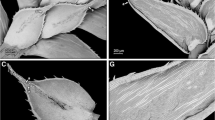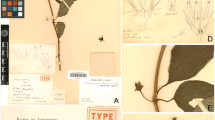Abstract
Aspazoma N.E.Br. GC 1925: 413; Bittrich 1987: 5–116; Gerbaulet 2001 in Hartmann 2001: 80–81; Klak et al. 2006: 353–400, Klak et al. 2007: 737–756; Gerbaulet 2012: 187–198; Klak & Bruyns 2013: 197–206 Typus A. amplectens (L.Bolus) N.E.Br. Etym Gk aspazomai, to embrace, referring to the leaf sheaths clasping the stems.
Access provided by CONRICYT-eBooks. Download reference work entry PDF
Similar content being viewed by others
Aspazoma N.E.Br. GC 1925: 413; Bittrich 1987: 5–116; Gerbaulet 2001 in Hartmann 2001: 80–81; Klak et al. 2006: 353–400, Klak et al. 2007: 737–756; Gerbaulet 2012: 187–198; Klak & Bruyns 2013: 197–206 Typus A. amplectens (L.Bolus) N.E.Br. Etym Gk aspazomai, to embrace, referring to the leaf sheaths clasping the stems.
Bushily branched, erect small shrubs with fibrous roots, I weakly lignified, articulate, young cortex green and succulent, drying with age and branches lignifying, with additional vascular bundles, with tall, isodiametric, closely packed, xeromorphic bladder cells; L cylindrical or slightly flattened on the upper surface, decussate, basally free, but each leaf with an overlapping stem-clasping sheath, deciduous, with central water-storing tissue as well as enlarged water storing cells in the chlorenchyma, with loosely arranged, mesomorphic, somewhat flattened bladder cells; Fl large, solitary, K 4–5, basally shortly connate, petals white to cream, basally connate into a tube, few filamentous staminodes present, nectaries shell-shaped; Fr a hygrochastic capsule with the valve wings inflexed over the expanded valves, 4–5 locules; S usually only 2 per locule, large, broadly egg-shaped, light brown to whitish, testa almost smooth; Ecol on quartzite hills, 300–600 m, rain in winter (Fig. 1); Distr Namaqualand, NC, S Africa.
Note: The monotypic genus Aspazoma was established by Brown (1925) for a species with basally free, decussate leaves forming a large, stem-clasping overlapping sheath. According to Klak et al. (2006), Aspazoma is most closely related to Dactylopsis. Both genera form a monophylum which in turn is the sister group to Brownanthus. All three share a green and succulent cortex with tall, closely packed, xeromorphic bladder cells and deciduous or marcescent leaves.
A. amplectens (L.Bolus) N.E.Br. 1926 in Phillips 1926: 244 ≡ M. amplectens L.Bolus in Pearson ASAM 1913: 153 LT, designated by Gerbaulet 2001 in Hartmann 2001: 81, Pearson 6064 (BOL!).
Shrub to 25 cm h, ∅ to 50 cm; L decussate, broadly overlapping (Fig. 2); I cylindrical, pith with styloids; Fl ∅ to 45 mm, vanilla-scented; Fr 7–9 mm, locules shallow; S usually only 2 per locule, to 2.2 mm l; Ecol as for genus; Distr as for genus.
Note: Flowering time is around September. Aspazoma may dominate the vegetation in places.
References
Bittrich V. (1987) Untersuchungen zu Merkmalsbestand, Gliederung und Abgrenzung der Unterfamilie Mesembryanthemoideae (Mesembryantheamceae FENZL). MIBH 21: 5–116
Bolus L. (1913) Ficoideae. In: Pearson H.H.W.: List of the plants collected in the Percy Sladen Memorial Expedition 1908–9, 1910–11, September 1911, continued. ASAM 9: 140–158
Brown N.E. (1925) Mesembryanthemum … GC 78: 232, 412–413, 433, 451, 468, 484, 500
Brown N.E. (1926) Mesembryanthemum s.lat. In: Phillips E.P. 1926: The genera of South African plants:241–249. Cape Times, Cape Town
Gerbaulet M. (2001) In: Hartmann, H.E.K. 2001: Illustrated Handbook of Succulent Plants: Aizoaceae A-E: Amoebophyllum: 37; Aptenia: 66–68; Aridaria: 75–80; Aspazoma: 80–81; Callistigma: 96; Cryophytum: 178–179; Dactylopsis: 182; Derenbergiella 211; Eurystigma: 268. Springer, Heidelberg
Gerbaulet M. (2012) One or many genera in Mesembryanthemoideae (Aizoaceae)? Discussion of a conflict in genus perception. Bradleya 30: 187–198
Hartmann H.E.K. (ed.) (2001): Illustrated Handbook of Succulent Plants: Aizoaceae A-E. Springer, Heidelberg
Klak C., Bruyns P.V. (2013) A new infrageneric classification for Mesembryanthemum (Aizoaceae: Mesembryanthemoideae). Bothalia 43: 197–206
Klak C., Bruyns P.V., Hedderson T.A.J. (2007) A phylogeny and new classification for Mesembryanthemoideae (Aizoaceae). Taxon 56: 737–756
Klak C., Nowell T.L., Hedderson T.A.J. (2006) Phylogeny and revision of Brownanthus and its close allies Aspazoma and Dactylopsis (Aizoaceae) based on morphology and four DNA regions. KB 61: 353–400
Pearson H.H.W. (1913) List of the plants collected in the Percy Sladen Memorial Expedition 1908–9, 1910–11, September 1911, continued. ASAM 9: 140–158
Phillips E.P. (1926) The genera of South African plants: 241–249. Cape Times, Cape Town
Author information
Authors and Affiliations
Corresponding author
Editor information
Editors and Affiliations
Rights and permissions
Copyright information
© 2017 Springer-Verlag GmbH Germany
About this entry
Cite this entry
Gerbaulet, M. (2017). Aspazoma Mesembryanthemoideae . In: Hartmann, H. (eds) Aizoaceae. Illustrated Handbook of Succulent Plants. Springer, Berlin, Heidelberg. https://doi.org/10.1007/978-3-662-49260-4_16
Download citation
DOI: https://doi.org/10.1007/978-3-662-49260-4_16
Published:
Publisher Name: Springer, Berlin, Heidelberg
Print ISBN: 978-3-662-49258-1
Online ISBN: 978-3-662-49260-4
eBook Packages: Biomedical and Life SciencesReference Module Biomedical and Life Sciences






